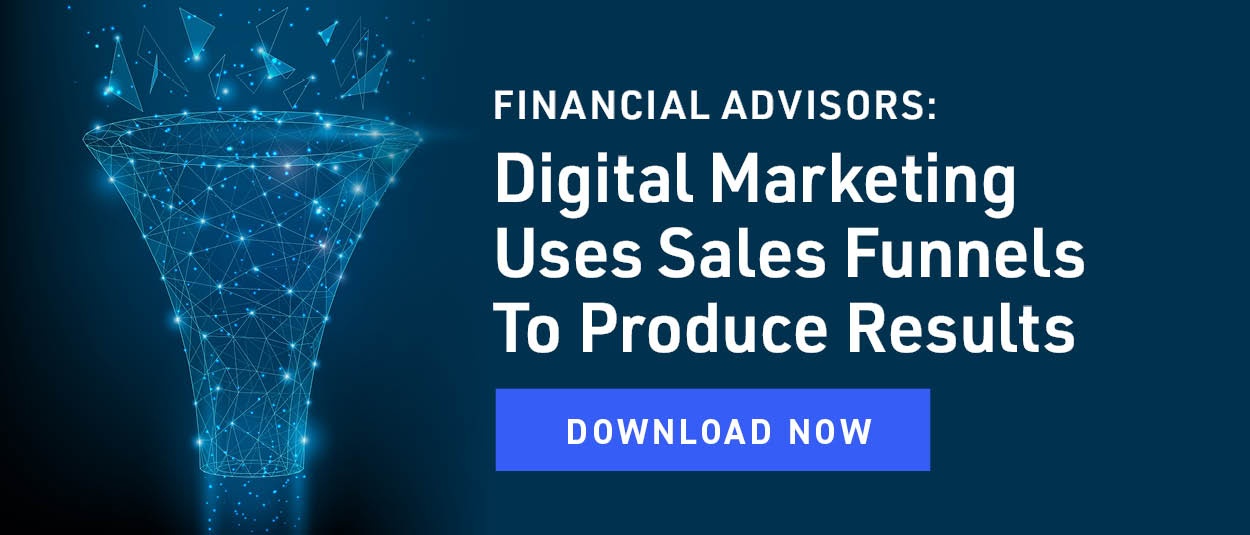

Why Doesn’t My Financial Advisor Website Produce More Leads?
This is the most frequent question we are asked by financial advisors.
Every financial advisor has had a website since their firms were start-ups, but they are lucky if their websites generate a handful of qualified leads per year. They are frustrated because they know some of their competitors have made digital marketing their primary source for new leads, prospects, and clients.
What do their competitors know that they don’t know? This article describes the seven deadly sins that negatively impact the productivity of financial advisor websites.
Digital Marketing aka Inbound Marketing
Financial advisors that want to grow say they have marketing strategies. After all, they need marketing to add new clients and not limit their growth to market appreciation and reinvested income. But, there is a good chance that strategy does not include digital marketing. They would be much better off if it did.
Most marketing strategies are still based on obsolete outbound marketing tactics that require financial advisors to initiate contact with investors. This has always been an invasive sales process because advisors are contacting investors who do not want the contact.
On the other hand, digital marketing for financial advisors is based on inbound marketing tactics that include investors initiating contact with advisors. This is a superior process that benefits both parties.
The Internet makes inbound marketing possible. This is where investors find financial advisors and learn more about them. Once they are convinced they have found the right financial advisors they contact them to schedule interviews.
Digital marketing is rapidly becoming a necessity for financial advisors that want to use the Internet to grow their businesses.
The Online Sales Brochure
Most older websites were designed to deliver information like a sales brochure, but they were never designed to produce leads for financial advisors. Even newer websites, that have more modern looks, still function as online sales brochures.
Why you ask? Website designers/developers do not want to be accountable for the production of leads - in particular investor leads.
There are substantial differences between online sales brochure websites and websites that are designed to produce leads for financial advisors. For example, both types of websites deliver information about financial advisors, but only one type is designed to produce a steady flow of high-quality leads that requires online visibility, website traffic, and functionality that converts visitors into leads.
Competitive Information
It is safe to assume most investors are visiting multiple websites when they use the Internet to find and research financial advisors. In fact, Google says they may visit up to six or eight financial advisor websites.
This is obviously an easy process when all they have to do is input a few keywords into a search engine. It is even easier than that when they launch their searches with voice commands that tend to be more explicit.
Once investors are on their websites, financial advisors have two minutes and thirty-three seconds (Paladin Survey) to help visitors learn more and to convince them to initiate contact.
This is a much easier process when investors find the information they are seeking and it is competitive with the other sites they visited.
The Right Connection
What investors see on the Internet and what they see on financial advisor websites should match. For example, they do not find content on the Internet that targets baby boomers who are about to retire and content on websites that target millennials. Financial advisors are much better off when their messaging and content are consistent.
There is another twist. A high percentage of investors prefer to work with specialists on the basis they will have better results. At a minimum, there is a conviction among investors that specialists produce better results because they know the needs of their clients better.
How financial advisors characterize Who They Serve on their websites is a very big deal. It may be the difference between investors contacting advisors and exiting the site for the next financial website on their lists.
The Right Website
Investors should know, in ten seconds or less, that they have come to the right website. This recognition is based on brand, logo, and elevator pitch on the home page. The messaging has to be 100% intuitive so they are not questioning this basic information.
Why do investors visit financial advisor websites? How about these three reasons:
- They want to interview the financial advisor.
- They want to learn more about the financial advisor.
- They are seeking financial information.
The interview is the simplest. They go to Contact Us and enter their contact information.
Learning more about the financial advisor is critical. They have to find the information they are seeking or they move on to the next website.
Financial information is delivered through the blog or a Resource Center on the website. This can also be complicated because financial advisors do not know the type of information they are seeking. That is why it pays to focus on content that involves financial points.
The Free Offer
Another financial advisor lead generation strategy is to provide a free eBook or webinar in exchange for their contact information. This exchange tends to appeal to investors who are seeking information about the firm or a financial topic. In fact, we recommend financial advisors have two free offers on their websites in the form of eBooks or webinars:
- Pick a serious financial pain point that impacts a lot of investors.
- Provide an eBook that helps them select the best financial advisor
As you might imagine, the second offer describes the characteristics of the financial advisor who is distributing a free eBook or providing the webinar.
A Safe Environment
If financial advisors put themselves in the shoes of investors it is easy to see how they may be concerned about providing their contact information to financial advisors. Are they going to get a lot of spam emails or telephone calls at inconvenient times? It may be unfair, but the industry does not have a stellar reputation for the treatment of investors.
This means financial advisors should go overboard on their websites making sure investors feel safe and comfortable providing their contact information.
A strong statement that they will not provide an investor’s contact information to any other firm or professional is important. A link to a strict Privacy Policy is even better. Both are best. The safer investors feel the higher the probability they will initiate contact.

Jack Waymire, BA, MBA
Search Here
Categories
- AI (18)
- blogging (2)
- branding (1)
- content (12)
- custodians (1)
- Digital (345)
- email marketing (3)
- fcmo (2)
- fees (1)
- financial advisor marketing (62)
- Google (3)
- Ideas & Tips (78)
- Investor Experience (7)
- lead generation (7)
- linkedin (1)
- Marketing (371)
- newsletters (1)
- Online Transparency (2)
- search engine optimization (3)
- seo (9)
- Social Media (2)
- video (2)
- Websites (108)
- YouTube channel (2)
Recent Posts
-

-

How Financial Advisor Blogging Generates Thought Leadership and Leads
November 24, 2025 -

Top 5 Ways Digital Marketing Benefits Financial Advisors Seeking Leads
November 20, 2025 -

Trust Is The Biggest Online Marketing Challenge For Financial Advisors
November 17, 2025 -

Compliant Financial Advisor Bios Using AI Website Builders
October 22, 2025

